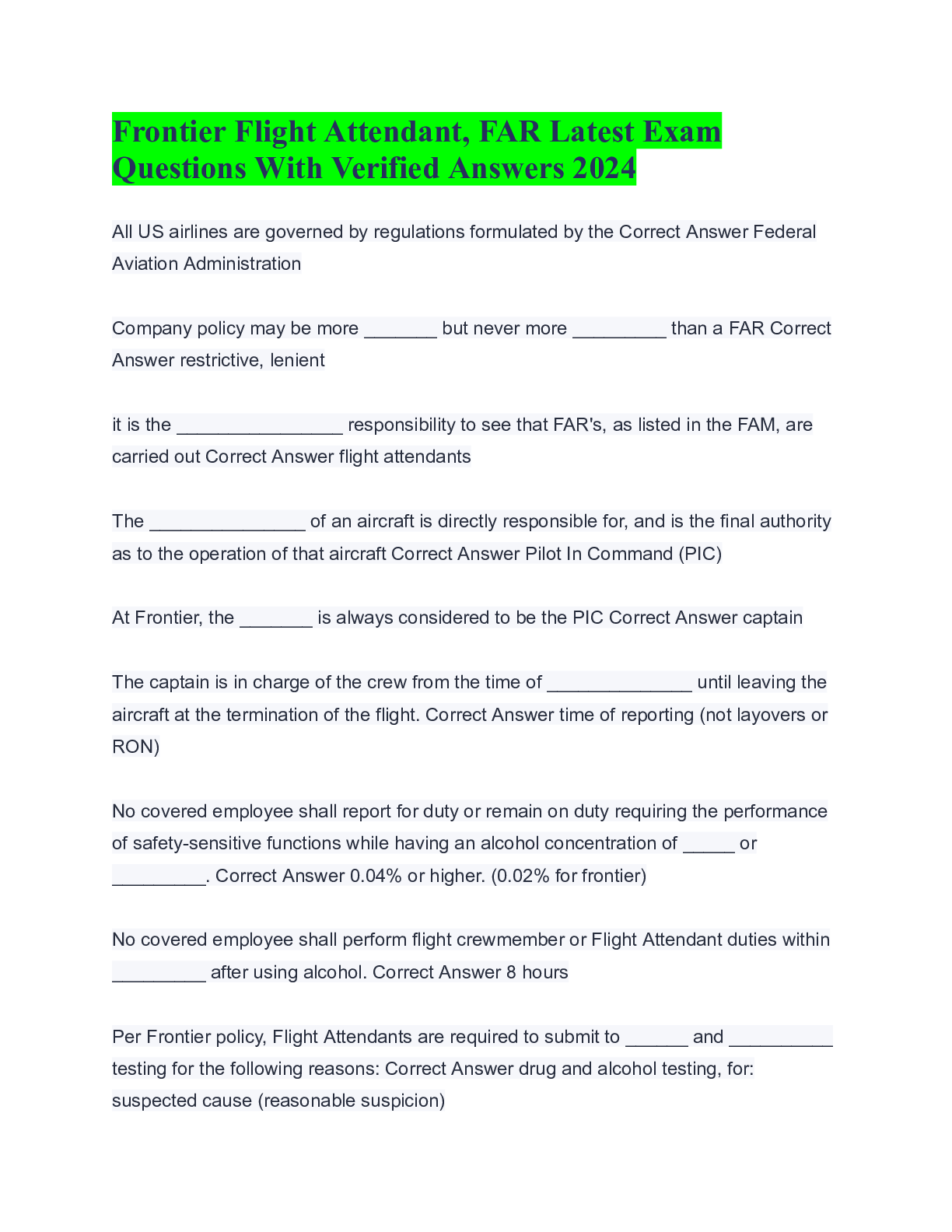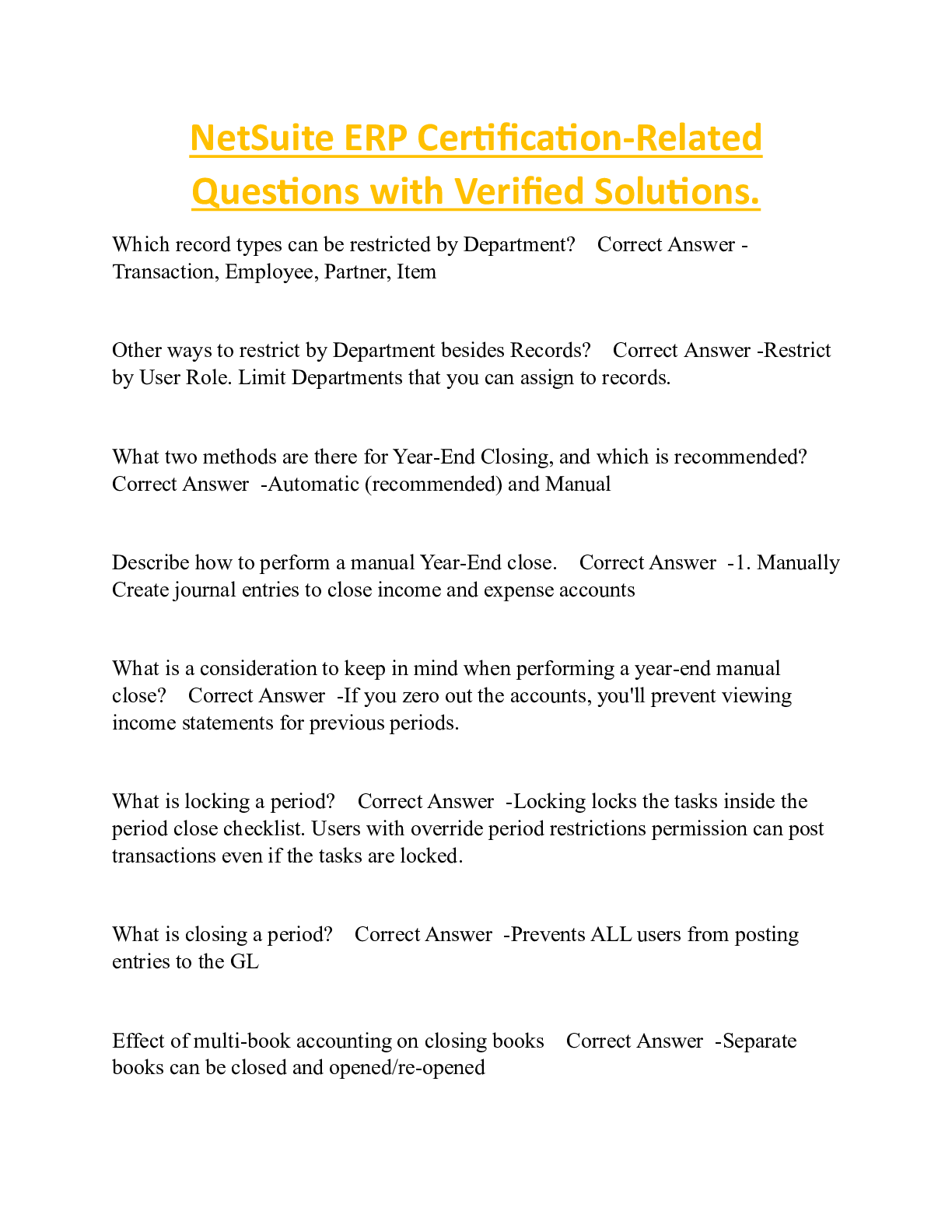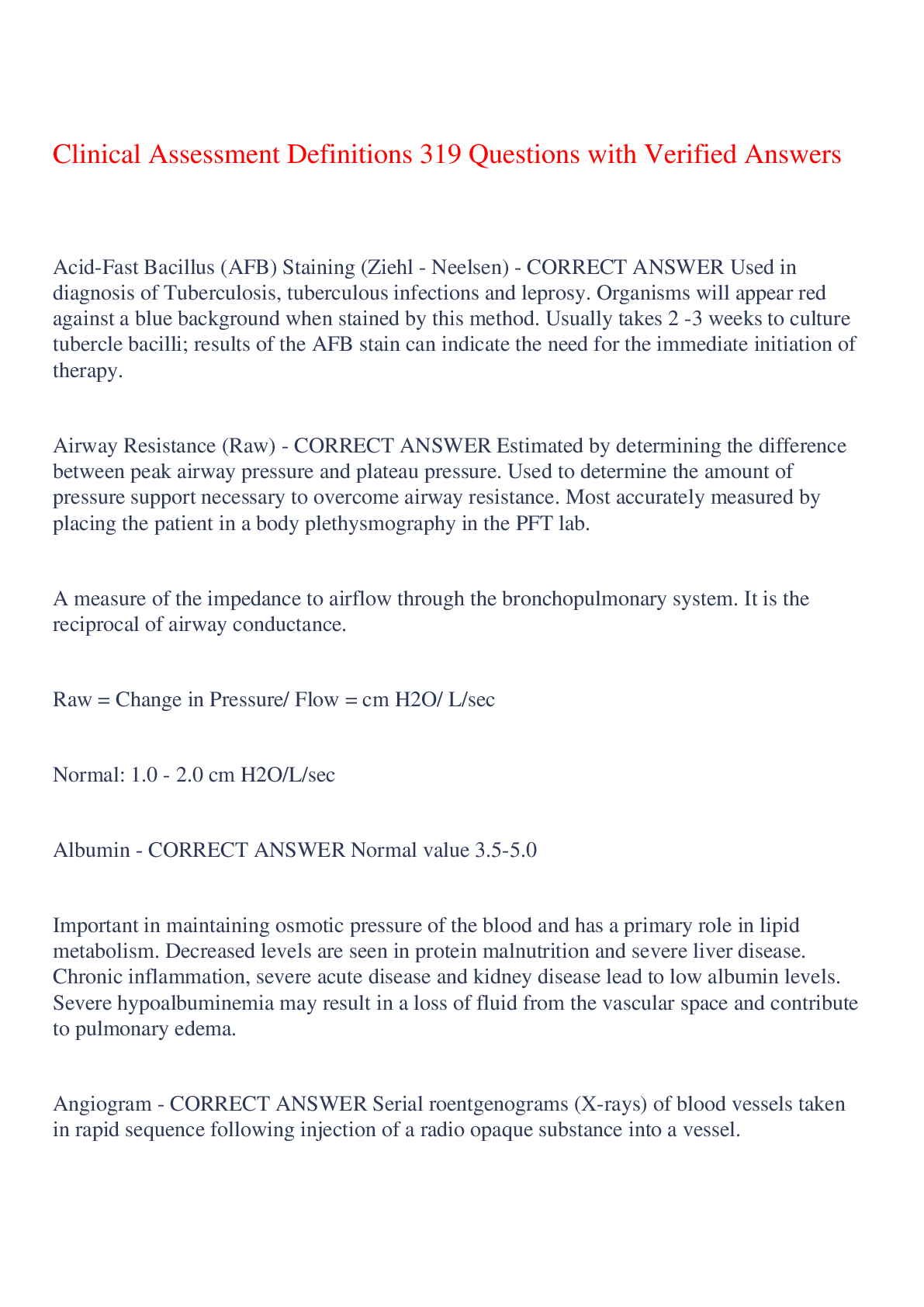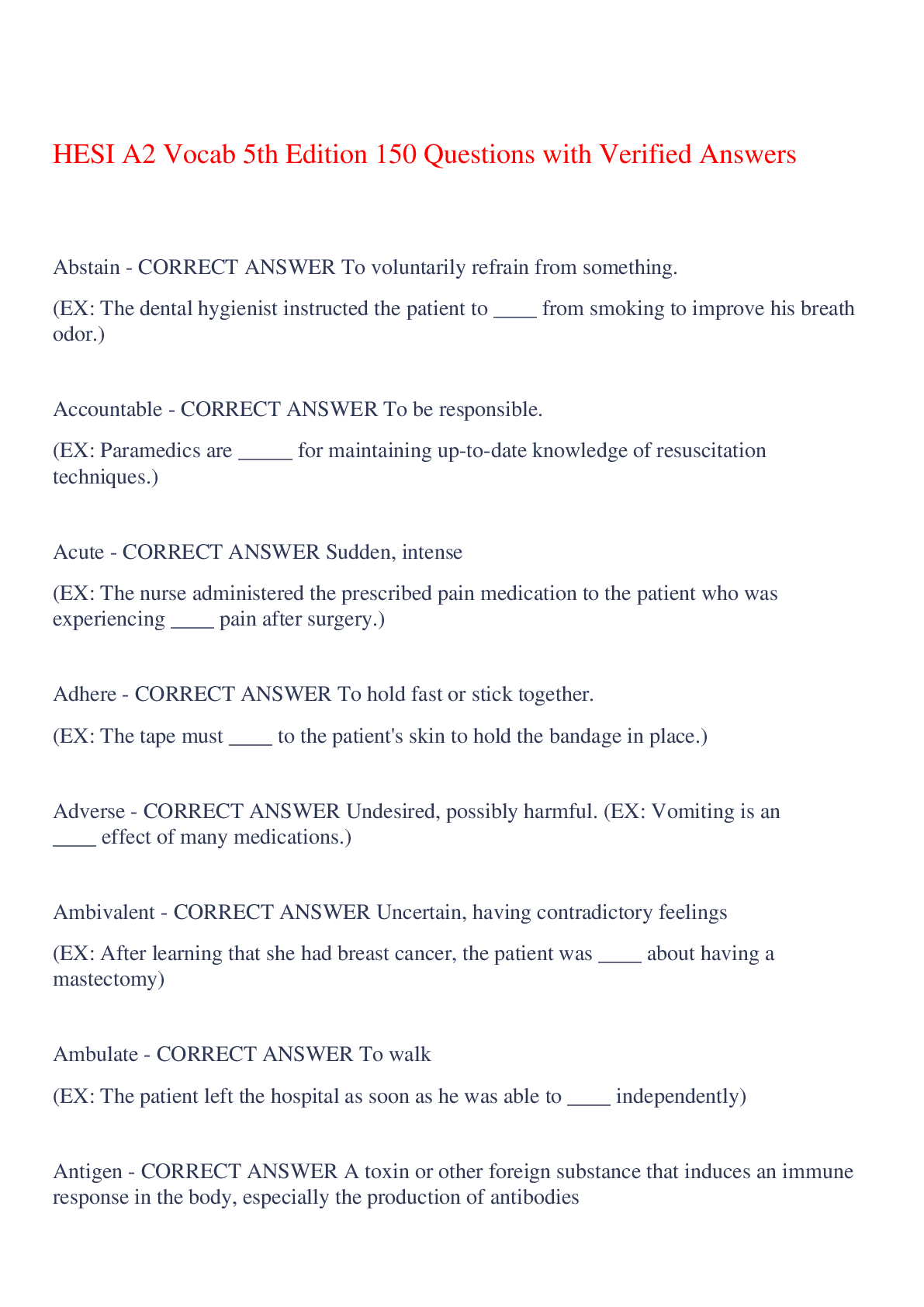Education > EXAM > ASVAB Electronics Practice Test 49 Questions with Verified Answers,100% CORRECT (All)
ASVAB Electronics Practice Test 49 Questions with Verified Answers,100% CORRECT
Document Content and Description Below
ASVAB Electronics Practice Test 49 Questions with Verified Answers Watt - CORRECT ANSWER measures electrical power (energy consumed) Ampere - CORRECT ANSWER measures electrical current (strength... ) Volt - CORRECT ANSWER measures electrical pressure Ohm - CORRECT ANSWER measures electrical resistance Hertz - CORRECT ANSWER measures frequency of alternating current short circuit - CORRECT ANSWER a circuit with no resistance ohm's law - CORRECT ANSWER the relationship between voltage, amperage and resistance amperes = volts / ohms - CORRECT ANSWER ohm's law (write it out) ohms = volts / amperes - CORRECT ANSWER find ohms from volts and amperes volts = amperes * ohms - CORRECT ANSWER find volts from amperes and ohms amperes = volts / ohms - CORRECT ANSWER find amperes from volts and ohms law of electric power - CORRECT ANSWER law dictating the amount of power consumed by a device watts = volts * amperes - CORRECT ANSWER law of electric power (write it out) step-up transformer - CORRECT ANSWER two electromagnets that increase the voltage of the current step-down transformer - CORRECT ANSWER two electromagnets that decrease the voltage of the current generator - CORRECT ANSWER device that changes kinetic into electric energy motor - CORRECT ANSWER device that changes electric into kinetic energy rotor - CORRECT ANSWER a spinning electromagnet stator - CORRECT ANSWER a stationary magnet capacitor - CORRECT ANSWER a device that briefly contains electricity resistor - CORRECT ANSWER a device that creates resistance to the flow of electrons transformer - CORRECT ANSWER a device that changes voltage and amperage of a current series circuit - CORRECT ANSWER a circuit where all moving electrons pass through every part of the circuit parallel circuit - CORRECT ANSWER a circuit where the voltage is the same at all points in the circuit total resistance - CORRECT ANSWER added resistance of all points in the circuit series-parallel circuit - CORRECT ANSWER combination of the two basic circuit types dopants - CORRECT ANSWER chemical that determines whether silicon will be an insulator or a conductor transistor - CORRECT ANSWER devices that can switch a current, regulate its flow or amplify a current diode - CORRECT ANSWER devices that allow a current to travel in only one direction rectifiers - CORRECT ANSWER devices that transform AC into DC 12 - CORRECT ANSWER gauge wire needed for 20-ampere circuit 14 - CORRECT ANSWER gauge wire needed for 15 ampere circuit Electrical power can be calculated with the following formula: P = I x V What does the letter I represent in this formula? A. watts B. voltage C. current D. impedance - CORRECT ANSWER The correct answer is (C) current. P represents power, which is measured in watts. I represents current, which is measured in amperes. V represents voltage which is measured in volts. What is the load in this basic circuit model? See Picture A. A B. B C. C D. D - CORRECT ANSWER The correct answer is (C) C. In a basic circuit model, there is a voltage source (pictured here as a battery at points A and B), a load, and conductors. The conductors are drawn using the lines and arrows. The load in this model is the light bulb pictured at point C. Examples of loads are light bulbs, resistors and motors. Three amps equals how many milliamps? A. 0.003 B. 30 C. 300 D. 3,000 - CORRECT ANSWER The correct answer is (D) 3,000.. A milliamp is one thousandth of an amp. So every amp equals 1,000 milliamps: 3 x 1,000 = 3,000. What type of electrical circuit is depicted above? See Picture A. simple circuit B. series circuit C. parallel circuit D. series-parallel circuit - CORRECT ANSWER The correct answer is (D). A series-parallel circuit has some loads wired in series and some loads wired in parallel. The loads in this circuit are R1, R2, and R3. R1 is wired in series while R2 and R3 are wired in parallel. What device would you use to measure electrical resistance in a circuit. A. ohmmeter B. voltmeter C. ammeter D. electricity meter - CORRECT ANSWER The correct answer is (A) ohmmeter. Electrical resistance is measured in ohms, and can be measured with an ohmmeter. Which of the following is NOT a type of resistor? A. potentiometer B. dielectric C. rheostat D. variable - CORRECT ANSWER The correct answer is (B). A potentiometer is a three terminal resistor with a sliding contact. A rheostat is a two terminal variable resistor. A variable resistor is any resistor that allows you to change the amount of resistance. Potentiometers and rheostats are both types of variable resistors. Which of these electrical devices can be used to store an electric charge? A. Semiconductor B. Diode C. Capacitor D. Transistor - CORRECT ANSWER Capacitors consist of one or more pairs of metal conducting plates that are separated by an insulator. The insulator is called the dielectric. An electric charge builds up when a voltage is applied across the plates, which creates an electric field. What does this symbol refer to? See Picture A. piezo transducer B. relay switch C. zener diode D. oscilloscope - CORRECT ANSWER The correct answer is (A) piezo transducer. A transducer is any device used to convert energy from one form to another. Piezo transducers are often used in microphones where they convert sound pressure to electrical voltage. The amount of energy used by a consumer in their home or business is typically measured in A. current B. amps C. voltage D. kilowatt-hour - CORRECT ANSWER The correct answer is (D) kilowatt-hour. A kilowatt-hour (kWh) is a unit of energy equivalent to one kilowatt (1 kW) of power expended for one hour AM radio stations broadcast in which frequency range? A. 530-1,700 kHz B. 7-1,002 MHz C. 1-40 GHz D. 60-1,000 AHz - CORRECT ANSWER The correct answer is (A) 530-1,700 kHz. Frequencies are measured in kilohertz, megahertz, or gigahertz. AM radio stations broadcast in the 530-1,700 kHz range. If a circuit has 8 volts of power and 4 ohms of resistance, what will the current equal? A. 1/2 amp B. 2 amp C. 4 amp D. 8 amp - CORRECT ANSWER Question 11 Explanation: The correct answer is (B) 2 amp. Current is measured in amps. The formula to use here is: I = V/R I = 8/4 I = 2 Which of the following is the correct definition of an electrical cell? A. A method of grounding an electrical current to the ground. B. A system of transporting current from one part of a component to another. C. A device that is capable of changing some form of energy (such as chemical energy) into electricity. D.An electrical device that can convert electric power into radio waves, and vice versa. - CORRECT ANSWER The correct answer is (C) A device that is capable of changing some form of energy (such as chemical energy) into electricity. An electrical cell supplies electrical current. Examples include batteries and solar cells. What is the voltage in a circuit with 10 amps of current and 6 ohms of resistance? A. 0.6 B. 1.7 C. 60 D. 600 - CORRECT ANSWER The correct answer is (C) 60. The formula to use here is: V = I x R V = 10 x 6 V = 60 The resistor color code for 2 is A. Black B. Brown C. Red D. Orange - CORRECT ANSWER The correct answer is (C) Red. The band code for a resistor is as follows: • Black is 0 • Brown is 1 • Red is 2 • Orange is 3 • Yellow is 4 • Green is 5 • Blue is 6 • Violet is 7 • Gray is 8 • White is 9 What type of switch is pictured above? See picture A. simple on/off B. changeover C. double pull double throw D. push-to-break - CORRECT ANSWER The correct answer is (D) push-to-break. Pushing the button breaks the circuit. When you release the button it returns to its normally closed (on) position. Which of the following is the SI unit representing one cycle per second? A. Ohm B. Frequency C. Ampere D. Hertz - CORRECT ANSWER The correct answer is (D) Hertz. The hertz, or Hz, is the SI unit of cycles per second and is a measurement of frequency. The Ohm is a measurement of resistance and the Ampere is a measurement of flow rate of electric charge. The rotor of a generator moves inside a circle of: A. batteries. B. light bulbs. C. heating coils. D. magnet. - CORRECT ANSWER D. magnet. [Show More]
Last updated: 4 months ago
Preview 1 out of 9 pages

Reviews( 0 )
Document information
Connected school, study & course
About the document
Uploaded On
Dec 25, 2023
Number of pages
9
Written in
Additional information
This document has been written for:
Uploaded
Dec 25, 2023
Downloads
0
Views
41





























